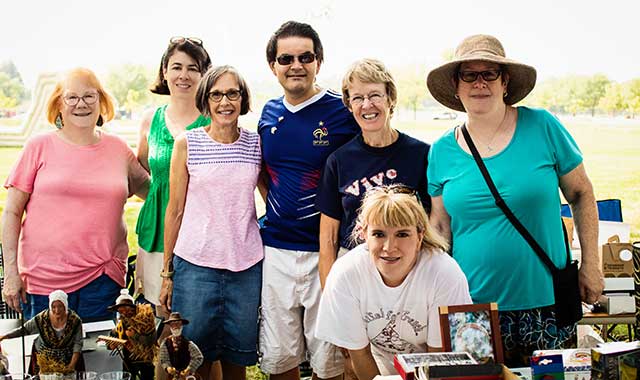From their origins in Prohibition and midcentury nightlife, the Wisconsin supper club remains a firm fixture in the hearts and imaginations of people beyond the Badger State.
Nothing stays the same forever. Yet, it is possible, on occasion, to feel like you’re in a place that’s truly timeless. Wisconsin diners know this feeling well.
Dotting the landscape of the Badger State, mom-and-pop restaurants known as supper clubs take us back to another time. Wisconsin’s supper clubs come in many varieties and attract many kinds of diners, but they all share something in common: for generations, they’ve captivated our imaginations, and they continue to entertain us today.

What is a Supper Club?
That’s the magic question, no matter whom you ask. For Ron Faiola, a Milwaukee-based documentary filmmaker and author, there’s no definitive answer – but you do know it when you see it.
“There are too many things to describe a supper club,” he says. “It’s a family-run place, but more than anything I think it’s an attitude.”
As a general rule of thumb, Wisconsin supper clubs are set on a vintage property with touches of the past. Inside, you’re almost certain to find what Faiola calls “the Holy Trinity” of twinkling lights, wood paneling and mounted animals. You may even find a fireplace inside.
Often, the bar opens at 4 p.m. and dinner starts an hour later. Waiting is customary, but that’s the point. This is the evening’s entertainment.
There’s no drink more familiar to a Wisconsin supper club than the brandy old-fashioned – mixed with brandy, a sugar cube, bitters, a maraschino cherry and a slice of mulled orange. Order it “sweet” with 7Up, “sour” with a sour soda or “press” with half 7Up and half soda water.
Friday fish fries and Saturday prime rib specials are standard fare – and everything on the menu is made from scratch. At some clubs you’ll also find a relish tray decked out with cut vegetables. These were a common table setting a generation ago.
A friendly proprietor is almost always on-site, at times even living upstairs or next door.
“It’s like you’re in their house, their dining room,” says Faiola. “They’re not open all the time, and they tend to have seasonal hours. In winter, they might be open less. When they go hunting, they put up a sign on the door that says, ‘We’ll be back next week.’”
Above all else, these places are full of nostalgia.
“Wisconsin’s reputation as a recreational state goes hand-in-hand with the supper club,” says Faiola. “A lot of these places are in remote areas, so when you’re staying in a cabin or you’re fishing, the supper club is just a perfect match. And for locals, too, it’s just where you go.”
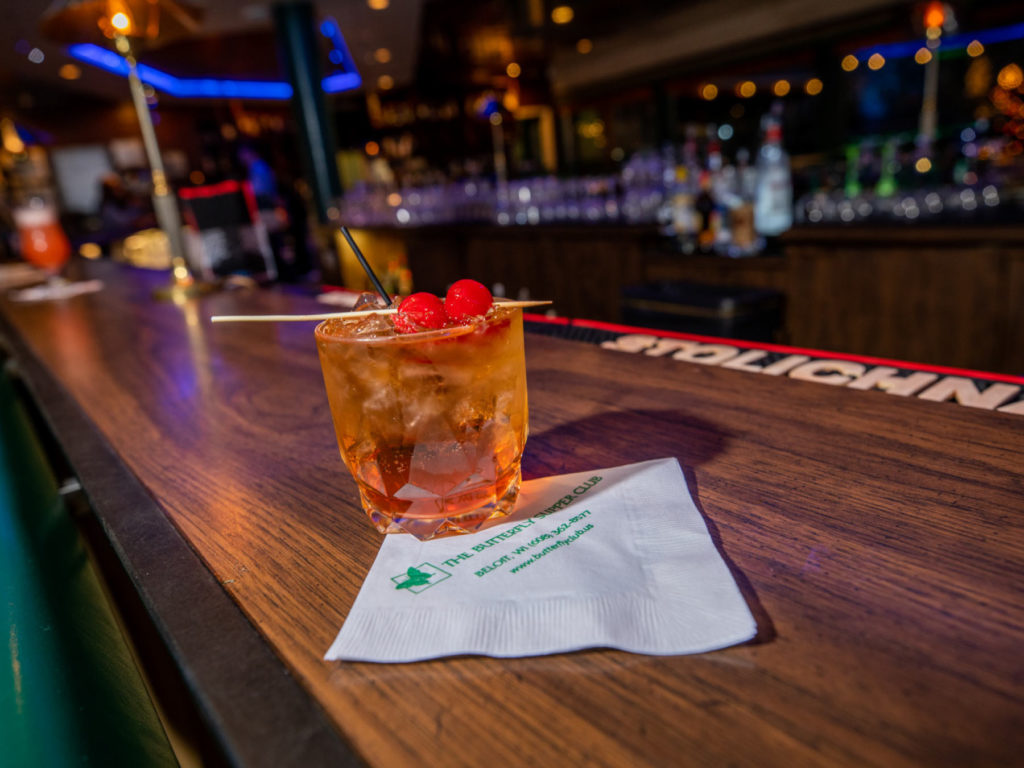
The Butterfly Club
One hundred years after it opened as a tea house outside Beloit, The Butterfly Club is about as classic as they come.
“We still have many of the same traditions we had when the Butterfly Club was operating maybe 50, 60, 70 years ago. You won’t find many changes,” says Hektor Sala, who owns the supper club with his brother, Mike. “You could take a picture in our bar today and it’ll look like it did years ago.”
Nostalgic touches abound in the bar, where many diners begin their evening. At the center is a vinyl-clad, wood-topped bar with seats all around. To one side, plush chairs line a wall of windows with views of the deck and the sloping fields outside. To the other side, a few steps up, sits another grouping of chairs and knee-high tables. Over in the corner, local musician Mike Williamson presents easygoing lounge music two to three nights a week.
“People come here before dinner and they go in the bar,” says Mike Sala. “After dinner, some people come back for an after-dinner drink and a dessert, like a grasshopper or a brandy alexander.”
There’s not a bad view in either of the Butterfly Club’s two dining rooms, which are lined with windows that further reveal the landscape outside. Metal chairs and linen tablecloths clue you in to the fine dining environment.
Prime rib, New York strip steak, rib eyes and seafood dishes such as shrimp de jonghe and escargot anchor the menu. Pan-fried chicken is the highlight Tuesday, Thursday and Sunday while the fish fry is special Wednesdays and Fridays. Saturday is the chef’s special.
“This is a place where you take your time, you relax, and you feel like home because the atmosphere hasn’t changed,” says Hektor.
The Butterfly Club got its start in 1924 when Hal and Mae Sherburne purchased 5 acres outside of town and opened a tea room with a kitchen, dining room and bar. Mike Molay bought it in 1946 and expanded the club. A fire destroyed the club in 1972, and it took 11 months to rebuild. The Camboni family took it over from Molay’s widow in 1977 and passed it to the Salas in 1999.
Natives of Albania, Mike and Hektor escaped communism in the early 1990s and made their way to America. They owned a café in Broadhead, Wis., before arriving in Beloit.
Today, The Butterfly Club is a family venture through and through. Not only will you find the Sala brothers around, but you’ll also find longtime employees and other members of the Sala family, including Hektor’s wife, Ujana, and son Aeneas.
People from Beloit, Rockford and Janesville frequent the club with people from faraway places. And, Mike says it’s all ages, with many younger diners inspired by Faiola’s books.
“We like this kind of atmosphere,” says Mike. “People are not in a hurry. When they come here, they plan to take their time. Nobody’s stressed out. They’re here to have a good time.”
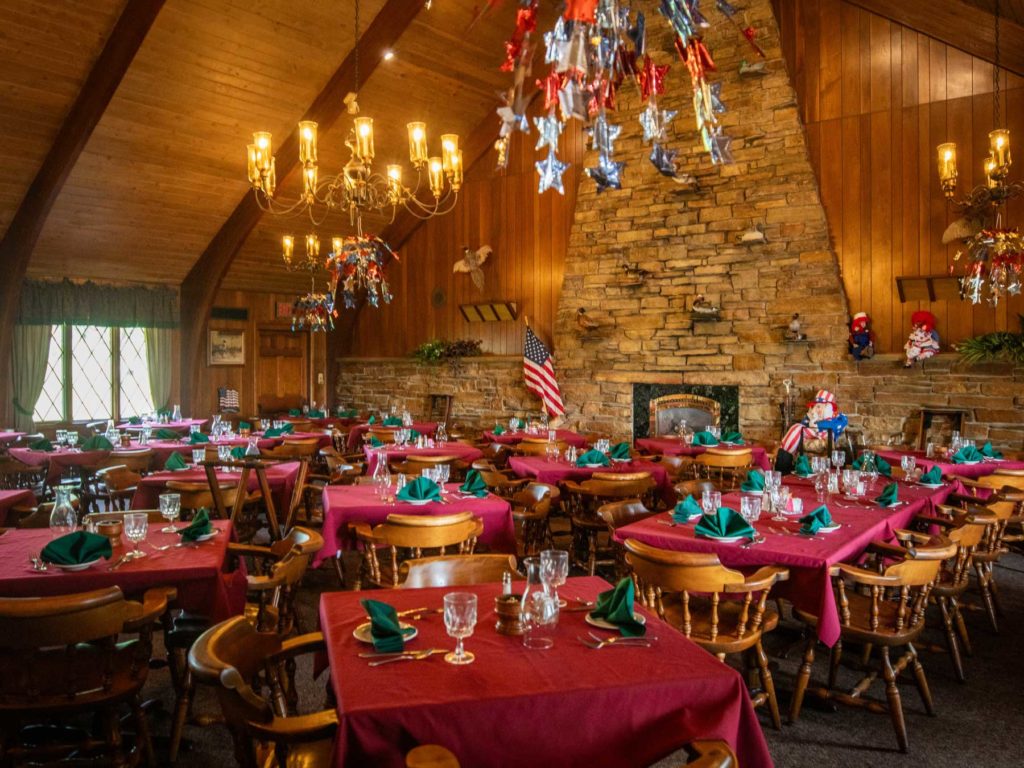
The Duck Inn
Its name actually comes from Prohibition, when patrons were encouraged to “duck in” for a drink, but these days it’s the waterfowl and a respected tradition that keep people returning to the Duck Inn, located about 8 miles northwest of Delavan. Ducks appear in nearly every corner – mounted on the wood-panel walls, hung over the grand fireplace, floating in the fish tank at the bar. And, they’re on the menu.
“We have roasted half-duck served on wild rice with your choice of sauce – a l’orange, cherry jubilee or mushroom sauce,” says owner Jeff Karbash. “We also have a roasted half-duck glazed with an apple-brandy glaze sauce and served on sauteed spaetzles, there’s the duck sampler served with all four sauces on the side, and the cashew duck breast served on basmati rice with an apricot drizzle.”
Of course, there’s also Saturday prime rib (king or queen cuts) and a Friday fish fry with beer-battered cod, broiled cod, beer-battered perch, smelt and a side of potato pancakes (another supper club staple).
Though Duck Inn doesn’t take reservations, Karbash encourages diners to call ahead for priority seating, where the wait is kept to around 20 or 30 minutes at peak times. Many people arrive early and head to the bar first.
Old-fashioneds – the bar’s top request – are made with brandy and a simple syrup mixed in-house. A full wine list is in good company with a Caribbean drink menu and old-fashioned cocktails with names like Harvey Wallbanger, Sidecar, Sloe Gin Fizz and Cuba Libre.
Desserts are also a must-have, and the real star is the vintage ice cream. The grasshopper, served with crème de menthe and crème de cacao, is a favorite for many. Karbash also serves classics like the brandy alexander (brandy and crème de cacao), the pink squirrel (crème de noyaux and crème de cacao) and the Golden Cadillac (galliano and crème de cacao).
“I would say the food and the atmosphere are the two biggest things people love here,” says Karbash. “You want good service, and we make that a priority, but I think people especially remember the meal and ambiance.”
Karbash, who bought the club in 1994, is the club’s eighth owner since its beginning sometime in the 1920s. Food service started after Prohibition, and it’s been a destination ever since. Karbash bought the club after it had sat vacant for eight years. Today, it’s still a beloved landmark for locals, vacationers and travelers.
“It’s a great meeting place for people,” he says. “I’ve noticed people will come back from a Badgers game on Saturday and it’s like all of a sudden we’re full of people from Kenosha and Racine.”
A Brief History
Popular legend suggests the modern supper club began with a Milwaukee entrepreneur in Beverly Hills, Calif., but according to research by Ron Faiola, it actually comes from Victorian England, where supper clubs arose with nightlife following a theatrical performance.
Like today’s nightclubs, these places centered around food, drinks and dancing. New York cabarets took it to a new level. Wisconsin’s clubs came about during Prohibition, when gangsters supplied easy booze to roadhouses and speakeasies, which were often located in rural locales. The postwar years saw the rise of family-friendly venues with appeal to vacationers and those seeking an evening out – and so they remain today.
Though many clubs have disappeared, Faiola’s books and documentary are introducing a new generation to this tradition.
“Thank God for Ron,” says Jeff Karbash, owner of The Duck Inn. “The industry has really changed since he started.”
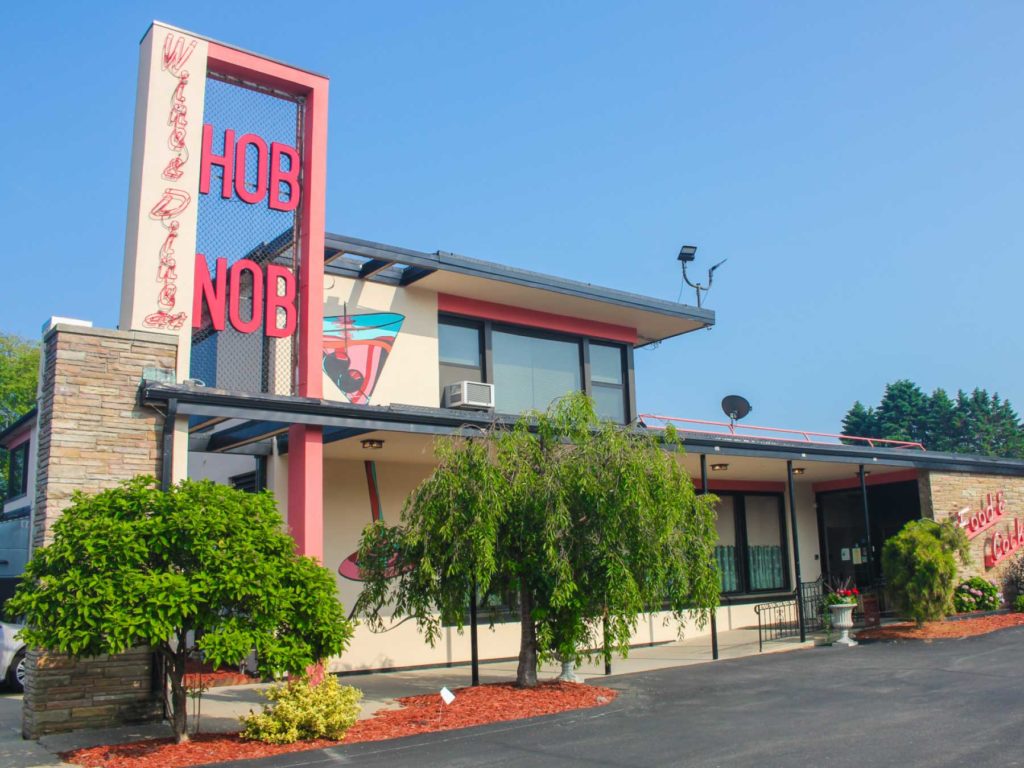
The Hobnob
The first thing you see when you arrive at the Hobnob in Racine is the blue water of Lake Michigan. Then, your eyes go to a sign that reads, “Stop. Lake Michigan Ahead.”
“That sign is world-famous,” says Michael Aletto, owner of Hobnob. It’s easy to see why.
Bill Higgins started the restaurant in 1937 in downtown Racine. He closed it during World War II and relocated Hobnob to its current location in 1954. The new building was inspired by a restaurant he visited in California. It was his son, Bill Higgins Jr., who’s credited with creating the lavish midcentury interior that remains a big part of Hobnob’s appeal. Aletto has preserved the glamorous decor and floor-to-ceiling windows that put the lake on full display.
“That Lake Michigan view has helped us survive and thrive,” he says.
Aletto had restaurant experience with the Four Seasons before buying Hobnob in 1990. Initially, he looked to buy it with a partner who wanted to change the decor, the menu, the food presentation and more. Aletto saw customers standing three deep at the bar, felt the Hobnob’s buzz and decided to go it alone – and tradition prevailed.
Over the years, Aletto has made some changes, including an expanded dining room that emphasizesthe lake views. The menu remains traditional supper club fare with steaks, prime rib, seafood, duck and German specialties still much the same as they were 30 years ago. Brandy old-fashioneds are still a traditional mix. Customers are invited to stay and relax, first at the bar and then over dinner. The Hobnob’s allegiance to tradition is part of the reason why it remains popular with patrons of all ages.
“I’m amazed by the way supper clubs have also become a favorite of the millennial generation,” says Aletto. We’re being discovered all over again.”
Aletto credits this revival in part to the work of Faiola, whose stories have become known across the country and made the old fashioned a national hit, he says.
“I am optimistic about the future of Racine and the Hobnob,” he says. “We were recently cited by Midwest Living magazine as the No. 1 supper club in the Midwest.”
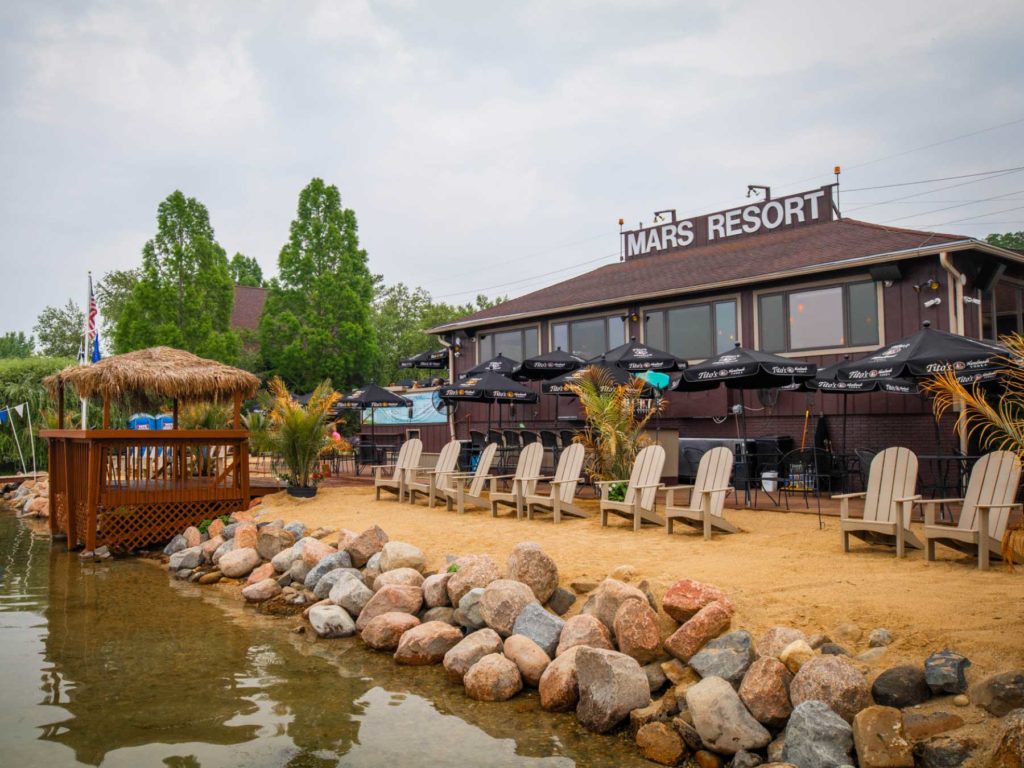
The Mars Resort
Supper clubs come in many forms in Wisconsin. Many are fine dining establishments, but some head the opposite direction and attract diners precisely for their laid-back atmosphere.
At the Mars Resort, located on the shore of Lake Como, a vintage setting mingles with a relaxed beachfront where it’s not uncommon to wait for a few hours for a table.
Scott Pohl, who owns Mars Resort with Arney and Sue Silvestri, wants patrons to enjoy every bit of the lakeside setting – from inside the dining room near a wall of windows or the Adirondack chairs and picnic tables set outside. Bands play outside on the weekend and drinks flow freely from the beachside bar. Guests can even enjoy a free ride on Mars’ 45-foot pontoon boat.
The menu features many supper club staples – prime rib and fish fry among them – and there’s a winter menu that features jaeger schnitzel and chicken pot pie. But it’s the ribs that really get people talking. Mars Resort sells some 15 tons of ribs every year. It starts with a sweet, tangy recipe developed years ago and perfected by chefs Cisco and Juan.
“Cisco has been here for 28 years, and Juan’s been here a long time, too,” says Pohl. “They make a great team in the kitchen.”
Pohl spent his childhood summers helping his dad rent boats at Interlaken Resort on Lake Como. He built a career in Chicago’s mortgage industry and watched things fall apart amidst the real estate collapse of 2007-’08. That’s when he reconnected with his childhood friend, Arney Silvestri, and the pair arranged to buy Mars Resort from longtime owner Don Woelky.
The pair took over in January 2016 and remodeled inside, while still remaining true to the heritage of the place.
Since then, Mars Resort been featured on the “Today” show and it’s acquired the French Country Inn just down the street. The allure of Mars remains its timeless atmosphere and age-old menu.
“We meet as guests, we become friends and you are eventually family. That’s the evolution,” says Pohl. “People come in, and initially you might not get it. Not everyone gets the experience. But pretty soon, we’re hugging each other and you’re here all the time. I love the relationships we build here. I love that people come and spend hours here, just so they can be here and not someplace else.”
Supper Club Fandom
Ron Faiola was looking for new business when he tapped into a cultural goldmine. Things were slow for the video producer in the 2008 recession, so he shot a documentary about fish fries in Milwaukee. The local PBS station licensed it, and it played to a beyond-sold-out crowd at Beloit International Film Festival in Beloit. Before long, Faiola was back on the road chronicling Wisconsin’s supper clubs, which he remembered from his childhood.
“‘Supper Clubs’ came out and there was a huge reaction,” says Faiola. “For example, at the Beloit International Film Festival, in 2012, they scheduled two showings. Those sold out, so they scheduled three more and those sold out.”
Soon after, Chicago’s Agate Publishing invited him to write a book. Faiola’s first two titles, which introduce clubs across Wisconsin, were followed by “The Wisconsin Supper Clubs Story,” which dives into the history of supper clubs. It won a gold medal from the Midwest Independent Publishers Association.
Since his first book in 2012, Faiola has found supper club groups that tour regularly, bloggers who share their stories online, and a fan base that seeks souvenirs and even autographs.
“It’s not just a coffee table book to some people,” says Faiola. “They don’t just leave it at home. They have it signed by people I wrote about, the owner or the chef perhaps. Sometimes they put paper menus in there and write what they had.”
This November, Faiola releases his fourth book, “Wisconsin Supper Clubs: Second Edition, Expanded and Updated.” Meanwhile, he also maintains a current listing of clubs at WisconsinSupperClub.com.



















































